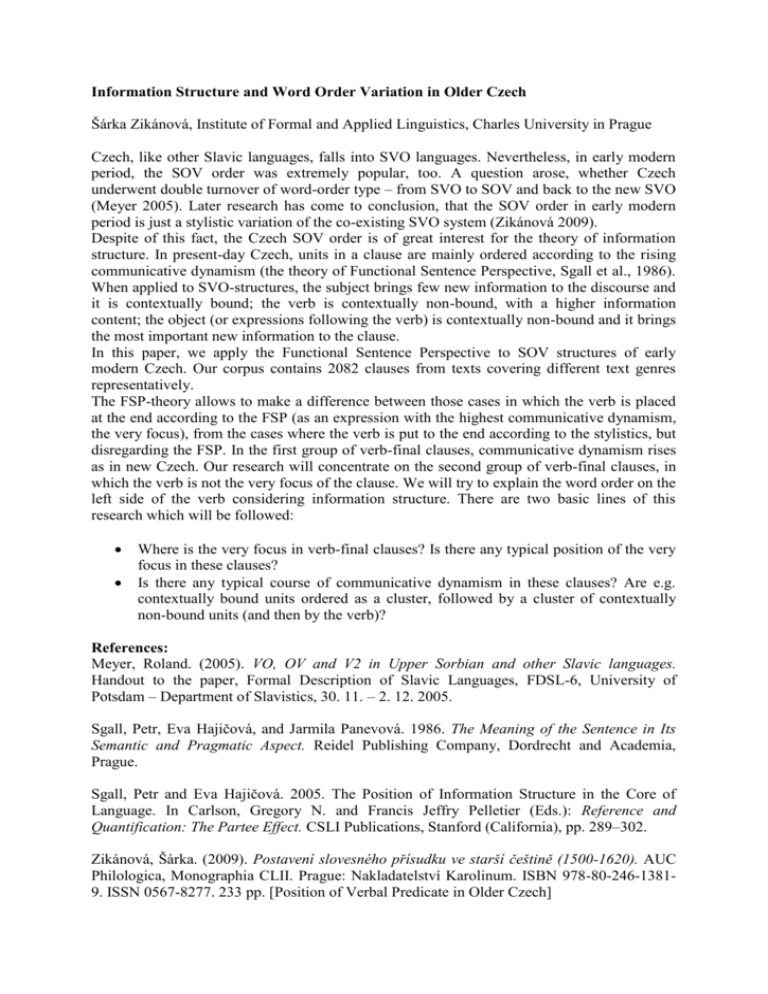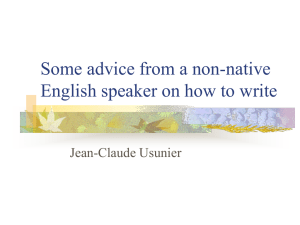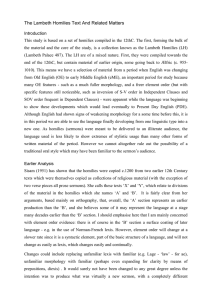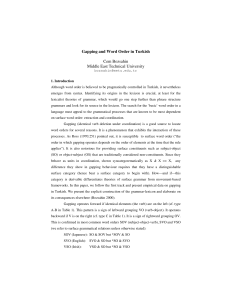Information Structure and Word Order Variation in Older Czech
advertisement

Information Structure and Word Order Variation in Older Czech Šárka Zikánová, Institute of Formal and Applied Linguistics, Charles University in Prague Czech, like other Slavic languages, falls into SVO languages. Nevertheless, in early modern period, the SOV order was extremely popular, too. A question arose, whether Czech underwent double turnover of word-order type – from SVO to SOV and back to the new SVO (Meyer 2005). Later research has come to conclusion, that the SOV order in early modern period is just a stylistic variation of the co-existing SVO system (Zikánová 2009). Despite of this fact, the Czech SOV order is of great interest for the theory of information structure. In present-day Czech, units in a clause are mainly ordered according to the rising communicative dynamism (the theory of Functional Sentence Perspective, Sgall et al., 1986). When applied to SVO-structures, the subject brings few new information to the discourse and it is contextually bound; the verb is contextually non-bound, with a higher information content; the object (or expressions following the verb) is contextually non-bound and it brings the most important new information to the clause. In this paper, we apply the Functional Sentence Perspective to SOV structures of early modern Czech. Our corpus contains 2082 clauses from texts covering different text genres representatively. The FSP-theory allows to make a difference between those cases in which the verb is placed at the end according to the FSP (as an expression with the highest communicative dynamism, the very focus), from the cases where the verb is put to the end according to the stylistics, but disregarding the FSP. In the first group of verb-final clauses, communicative dynamism rises as in new Czech. Our research will concentrate on the second group of verb-final clauses, in which the verb is not the very focus of the clause. We will try to explain the word order on the left side of the verb considering information structure. There are two basic lines of this research which will be followed: Where is the very focus in verb-final clauses? Is there any typical position of the very focus in these clauses? Is there any typical course of communicative dynamism in these clauses? Are e.g. contextually bound units ordered as a cluster, followed by a cluster of contextually non-bound units (and then by the verb)? References: Meyer, Roland. (2005). VO, OV and V2 in Upper Sorbian and other Slavic languages. Handout to the paper, Formal Description of Slavic Languages, FDSL-6, University of Potsdam – Department of Slavistics, 30. 11. – 2. 12. 2005. Sgall, Petr, Eva Hajičová, and Jarmila Panevová. 1986. The Meaning of the Sentence in Its Semantic and Pragmatic Aspect. Reidel Publishing Company, Dordrecht and Academia, Prague. Sgall, Petr and Eva Hajičová. 2005. The Position of Information Structure in the Core of Language. In Carlson, Gregory N. and Francis Jeffry Pelletier (Eds.): Reference and Quantification: The Partee Effect. CSLI Publications, Stanford (California), pp. 289–302. Zikánová, Šárka. (2009). Postavení slovesného přísudku ve starší češtině (1500-1620). AUC Philologica, Monographia CLII. Prague: Nakladatelství Karolinum. ISBN 978-80-246-13819. ISSN 0567-8277. 233 pp. [Position of Verbal Predicate in Older Czech]










